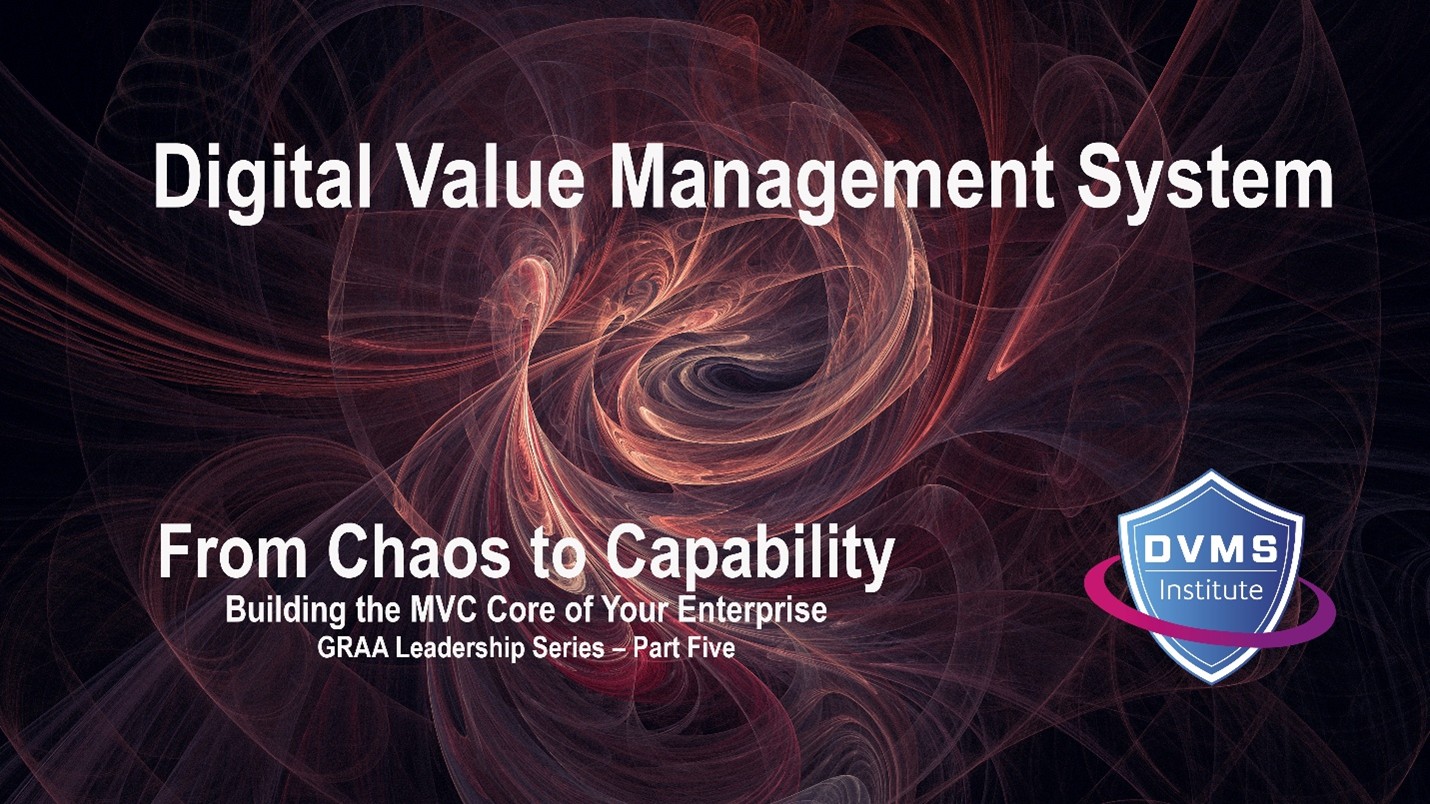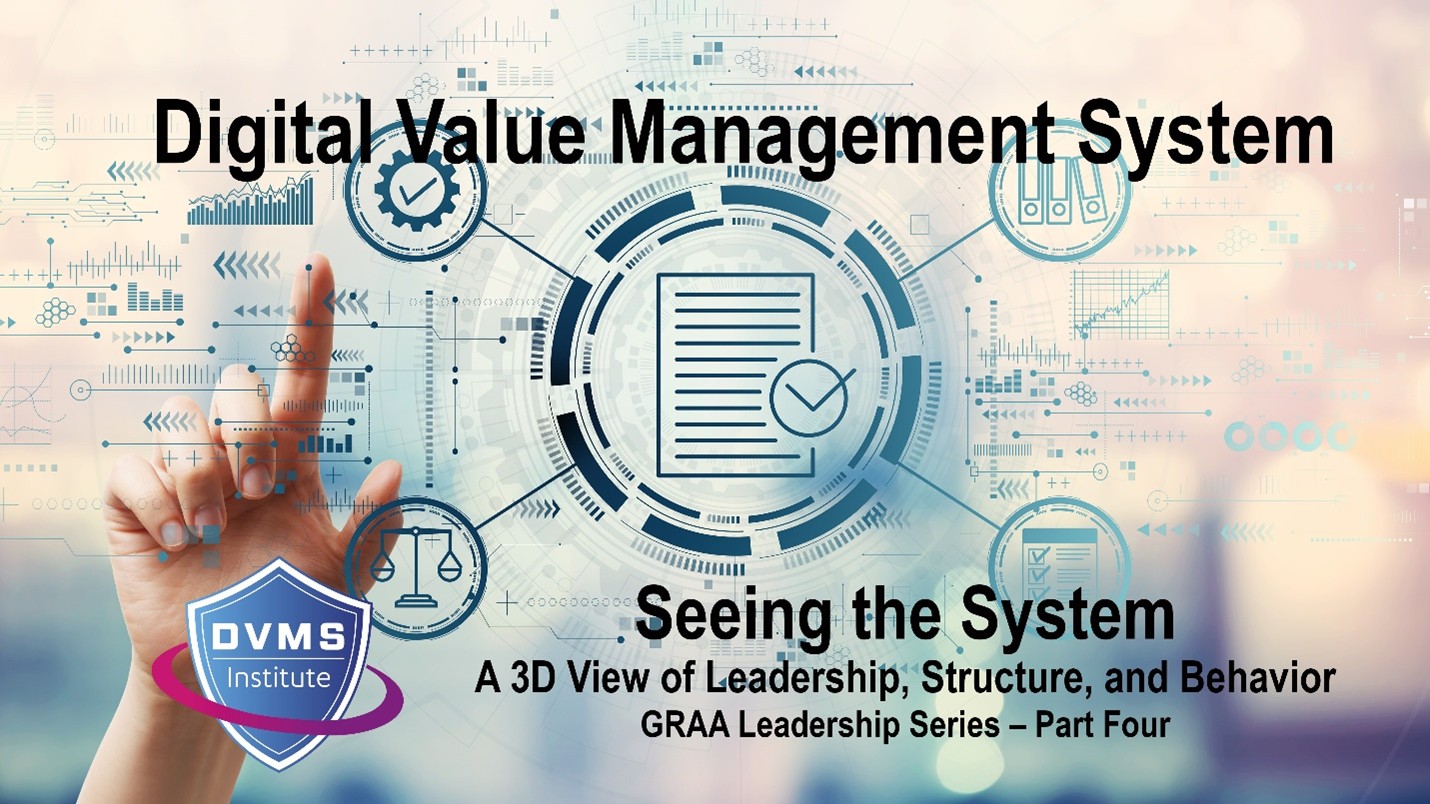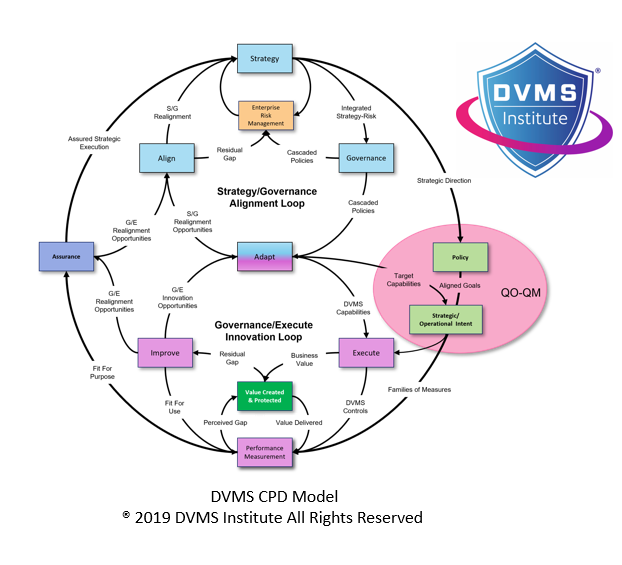The ABCs of GRA – Moving from Static GRC to Dynamic Digital Mastery
David Nichols – Co-Founder and Executive Director of the DVMS Institute
If you sense that traditional Governance, Risk, and Compliance (GRC) models are falling behind the pace of today’s digital business environment, you’re right. GRC was built for an era where risks could be anticipated in slow-moving cycles, policies could sit on shelves for years, and compliance audits were enough to prove good governance.
That world is gone. It went away along with the 20th century.
Today, organizations live in a reality of velocity, volatility, and constant disruption. The structures and mindsets built for a slower economy simply aren’t equipped to handle the speed and complexity of digital business. This is why a new model, Governance, Resilience, and Assurance (GRA), is gaining traction.
This article explains the ABCs of GRA: how we got here, where organizations must go, and how the Digital Value Management System (DVMS) offers a proven path for making the shift not just possible but scalable and sustainable.
A is for Acknowledge: The Limits of Traditional GRC
The first step is recognizing the uncomfortable truth: GRC isn’t built for today’s world.
In its traditional form, GRC assumes that governance can be imposed top-down through static policies. It imagines that risk can be assessed periodically and then parked neatly in a register until the next review cycle. It treats compliance as an exercise in documentation rather than an integrated part of value creation.
Meanwhile, digital enterprises operate in an environment where new business models emerge overnight, regulatory expectations shift quarterly, and competitive threats materialize faster than traditional controls can adapt. Cyber risks, market shocks, and technology shifts don’t wait for scheduled audits.
In this environment, GRC becomes a drag. It introduces friction at the very moment when speed, adaptability, and resilience are the new currencies of success.
Acknowledging this isn’t a criticism of GRC’s intent; it’s simply a recognition that the ground under our feet has shifted, and we need new ways to govern, manage risk, and assure outcomes.
B is for Build: A New Vision for Governance, Resilience, and Assurance
Having acknowledged the problem, the second step is to build a new vision reflecting the digital business’s realities.
GRA isn’t just a rebranding of GRC. It’s a profound reimagining. It recognizes that governance today must be dynamic, that resilience must be designed into operations, and that assurance must be continuous rather than retrospective.
In a GRA-driven organization, governance is not a matter of issuing static policies. It’s about dynamically guiding value creation, protection, and delivery flow. It’s about enabling decision-making at every level, informed by real-time information and aligned to strategic intent.
Resilience moves from being a disaster recovery plan to becoming a characteristic of the operating model itself. Resilient organizations don’t just bounce back from disruption; they absorb shocks and adapt faster than their competitors.
And assurance no longer waits for annual audits. It becomes a living function — continuously validating that the strategic organizational objectives are being realized, risks are being managed within appetite, and value is being delivered in a measurable, defensible way.
GRA offers a vision of an organization that is not paralyzed by uncertainty but empowered by it.
C is for Connect: How DVMS Turns Vision Into Reality
The third step—and perhaps the most critical—is figuring out how to integrate strategy, governance, and operations into a system that can deliver on GRA’s promise.
This is where the Digital Value Management System (DVMS) comes into play.
A key insight from “Thriving on the Edge of Chaos,” which forms the foundation of the DVMS approach, is that success is not about managing governance, risk, and assurance as separate functions. Instead, it involves integrating these elements into the core of the organization’s processes for creating, protecting, and delivering digital business value.
The DVMS enables this by introducing several crucial disciplines, starting with the concept of strategy-risk.
In most traditional models, strategy and risk are treated separately. Leaders set strategic goals, and only afterward do risk managers attempt to assess the threats to those plans. DVMS rejects this separation. It insists that strategy and risk must be conceived together. When a company defines a new product initiative, expands into a new market, or adopts a new technology, the associated risks are identified and embraced as part of strategic execution, not after-the-fact considerations.
This approach ensures that risk is not an obstacle to innovation but a dimension of strategy itself. It empowers organizations to take bold steps with open eyes, managing risks dynamically rather than trying to eliminate them retroactively.
But DVMS doesn’t stop there. Through its 3D Knowledge Model, it also structures how knowledge flows across the enterprise, connecting strategic, governance, and operational knowledge into a continuous feedback loop.
At the strategic level, leadership articulates clear digital value outcomes, defines acceptable risk parameters, and sets the policies that guide behavior. Governance functions translate these into adaptive frameworks and controls that can evolve in response to operational realities. Operational teams execute on those strategies, generating real-world data about performance, risks, and opportunities, which flows back to inform governance adjustments and strategic recalibrations.
This dynamic movement of knowledge is the lifeblood of GRA. Without it, governance becomes detached, resilience becomes reactive, and assurance becomes meaningless. With it, the organization achieves alignment across layers — strategy shaping action, action informing strategy — in an ongoing cycle of adaptation and learning.
Finally, DVMS shows how to scale GRA without sacrificing agility. By defining Minimum Viable Capabilities (MVCs) necessary for governance, resilience, and assurance at each level, it avoids the trap of bureaucracy. Organizations don’t have to build massive overhead to achieve dynamic governance; they build only what is necessary to maintain alignment, adaptability, and value delivery.
The Journey from GRC to GRA
When you step back and view the full arc, the journey from GRC to GRA is a journey from rigidity to resilience, reaction to anticipation, disconnected functions to integrated digital value management.
In the world of GRC, governance imposes policies. Risk management catalogs dangers. Compliance checks boxes.
In the world of GRA, governance empowers decisions, risk management enables innovation, and assurance continuously validates strategic success.
Where GRC struggles to keep up with the pace of change, GRA surfs on it.
Where GRC isolates governance and risk management from operations, GRA embeds them into creating and delivering digital business value.
Where GRC looks backward, GRA looks forward.
Final Thoughts: Scaling GRA is a Strategic Imperative
Today’s organizations don’t just compete on products or services. They compete on how well they can navigate disruption — how resilient they are, how adaptive their governance is, how continuously they can assure value delivery in an uncertain world.
Scaling GRA is no longer optional. It’s a strategic imperative.
By embracing the DVMS approach, embedding strategy-risk into planning and execution, and flowing knowledge dynamically across the 3D Knowledge Model, organizations can transform the way they govern, adapt, and thrive.
The ABCs of GRA aren’t just a new way to think. They’re a new way to operate — a roadmap for building organizations capable of thriving at the edge of chaos.
About the Author

Dave is the Executive Director of the DVMS Institute.
Dave spent his “formative years” on US Navy submarines. There, he learned complex systems, functioning in high-performance teams, and what it takes to be an exceptional leader. He took those skills into civilian life and built a successful career leading high-performance teams in software development and information service delivery.
The DVMS Institute’s NIST Cybersecurity Framework Digital Value Management System® certified training programs teach Service Providers of any type the skills to build a Holistic, Adaptive, and Culture-Powered Cyber Resilience Overlay System capable of proactively identifying and mitigating the systemic risks that could impact cyber business operations.
The NIST-CSF-DVMS positions cyber resiliency not as a technical function but as a strategic, enterprise-wide responsibility. This systems-based approach mandates engagement from top Leadership to Frontline Employees , each fulfilling distinct duties.
Enabling Resilience requires coordinated action across an organization’s Strategy, Governance, and Operations business layers. Each of these layers contains unique roles that, when aligned and functioning cohesively, enable the organization to protect cyber business assets and adaptively manage cyber business risks while delivering sustained cyber business operations and resilience.
Enabling this unique and innovative approach to Adaptive Governance, Resilience, and Assurance service providers can now comply with any government-mandated cyber regulation (SEC, DORA, NIS2 etc.) or maturity model program (SCF, HITRUST, CMMC etc.).
® DVMS Institute 2025 All Rights Reserved




